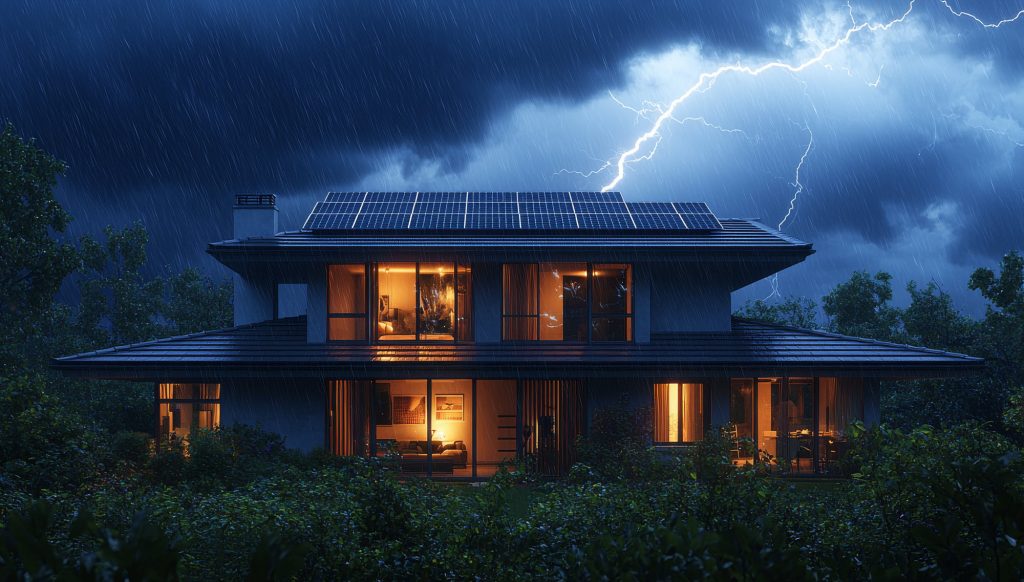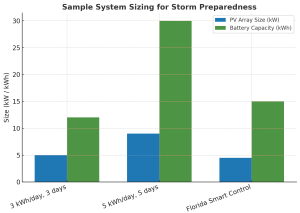
Real-World Context: Outage Duration & Weather Realities
Severe storms, including hurricanes, account for a significant portion of the nation’s longest power interruptions. From 2000 to 2023, tropical cyclones represented about 14 % of weather-related outages but were responsible for many of the longest-lasting outages (Climate Central, 2024). Hurricane Irma, for instance, left up to 94 % of customers in parts of Florida without power for days, with some areas experiencing outages for over 20 days (Wikipedia, 2025).
Even outside hurricanes, the average U.S. customer still experienced 5.5 hours of interruptions in 2022 (U.S. Energy Information Administration [EIA], 2023). These realities underscore the need for systems capable of sustaining multi-day autonomy.
Sample System Sizing: Case Examples & Metrics
Puerto Rico Micro-Grid Example
In Adjuntas and Jayuya, microgrid phases included 41 kW of solar PV paired with 74 kWh of battery storage across five sites, followed by 74 kW PV with 92.5 kWh storage (Environmental and Energy Study Institute [EESI], 2019). Proportionally, a home with 5 kWh/day of critical loads might require ~20 kW PV and 40–60 kWh storage.
Storm Resilience Study (Florida Home Simulation)
Modeling of a Florida home during Hurricane Irma found that an intelligent control system reduced required PV + battery capacity by up to 50% while still maintaining resiliency compared to rule-based systems (Arghandeh et al., 2021).
NREL Resilience Modeling
National Renewable Energy Laboratory (NREL) modeling scenarios demonstrated the viability of hybrid systems combining PV, batteries, and generators to cost-effectively ensure autonomy during prolonged outages (New York Solar Map, 2017).
Solar Insolation & Recharge Planning
To ensure batteries recharge after hurricanes, solar arrays must be sized against low-insolation periods. While Florida and Gulf states generally receive ample annual sunlight, cloudy or rainy days post-storm can stall recharge. Installers often oversize arrays by 50–100% beyond average daily consumption to account for reduced irradiance (Morningstar Corporation, 2024).
Enhanced Hybrid Systems: Resilience Meets Flexibility
Hybrid inverter systems, like the Sol-Ark 15K-2P are widely recommended in hurricane-prone areas. They provide UPS-level switchover with expandable capacity, to help enable long-duration off-grid operation without the noise, fuel, or emissions of generators. Sol-Ark residential energy storage systems allow seamless switchover to off-grid operation, support modular battery expansion, and maintain critical loads instantly during outages (Florida Solar Design Group, 2025).
Actionable Sizing Examples (Based on a Typical Home)
- 3 kWh/day critical load, 3-day autonomy Battery: ~9 kWh usable (12 kWh nominal); PV: ~5 kW
- 5 kWh/day critical load, 5-day autonomy Battery: ~25 kWh usable (30–35 kWh nominal); PV: ~8–10 kW
- Intelligent control (Florida case) ~4–5 kW PV + ~15 kWh battery vs. 8–10 kW PV + 30 kWh battery

Putting It All Together: A Data-Driven Checklist
- Estimate critical load in kWh/day.
- Select autonomy target—3–5 days based on regional outage history.
- Size battery: daily load × days ÷ depth of discharge (e.g., Li-ion at 80 % usable).
- Size PV array: sufficient to recharge batteries in low-sun periods.
- Apply intelligent controls to reduce system footprint.
- Choose a hybrid inverter system for seamless resilience and scalability.
By combining realistic outage data, case study examples, and weather-specific planning, homeowners can design solar-battery systems that truly deliver during hurricane season. Hybrid inverter systems, paired with carefully sized batteries and PV arrays, offer not only storm resilience but also long-term independence and peace of mind.
References
Arghandeh, R., Qiu, Y., & Stewart, E. (2021). Intelligent control for resilience in distributed energy resources. arXiv. https://arxiv.org/abs/2102.04406
Climate Central. (2024). Weather-related power outages are rising across the U.S. Climate Central. https://www.climatecentral.org/climate-matters/weather-related-power-outages-rising
EESI. (2019). Microgrids in Puerto Rico keep rural communities connected. Environmental and Energy Study Institute. https://www.eesi.org/articles/view/microgrids-in-puerto-rico-keep-rural-communities-connected
Florida Solar Design Group. (2025, June 22). A no-nonsense guide to understanding your solar battery options in 2025. https://floridasolardesigngroup.com/a-no-nonsense-guide-to-understanding-your-solar-battery-options-in-2025
Morningstar Corporation. (2024, December 11). Off-grid PV system load control: System sizing and PSOC. https://www.morningstarcorp.com/off-grid-pv-system-load-control-system-sizing-and-psoc
New York Solar Map. (2017). Economic and resiliency impact of PV and storage. https://nysolarmap.com/media/1636/economic-and-resiliency-impact-of-pv-and-storage.pdf
U.S. Energy Information Administration. (2023, January 10). U.S. electricity customers experienced an average of about 5.5 hours of power interruptions in 2022. https://www.eia.gov/todayinenergy/detail.php?id=61303
Wikipedia. (2025). Effects of Hurricane Irma in Florida. In Wikipedia. https://en.wikipedia.org/wiki/Effects_of_Hurricane_Irma_in_Florida
